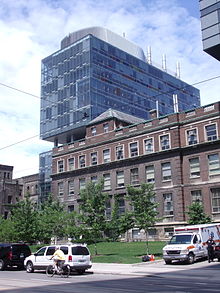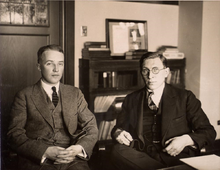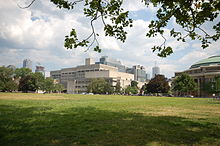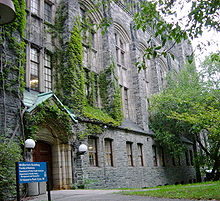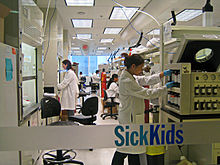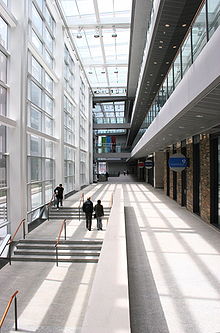- University of Toronto Faculty of Medicine
-
The Faculty of Medicine, University of Toronto is the medical school of the University of Toronto. The faculty is based in the Discovery District of Downtown Toronto along with most of its teaching hospitals and research institutes. Founded in 1843, it is one of Canada's oldest institutions of medical studies, and is known for the discovery of insulin and stem cells. The High Impact Universities 2010 World University Ranking places the University of Toronto at 7th worldwide in the 'Medicine, Dentistry, Pharmacology and Health Sciences' category. [1]
Contents
History
The university originally opened its medical school in 1843, providing instruction in medicine and medical sciences. In 1853, it suspended the school's teaching program and transferred teaching duties to the city's three proprietary schools: Trinity Medical College, the Toronto School of Medicine and Woman's Medical College. Because proprietary schools could not grant degrees, the university's medical school retained the responsibility of holding examinations and conferring medical degrees. As the university kept raising its standards, the medical examinations became increasingly rigorous and scientific.[2] This led to fewer medical students from proprietary schools deciding to obtain university degrees, which were not required for medical practice at the time.[2]
In 1887, the university resumed medical teaching in its Faculty of Medicine. The faculty promptly absorbed the Toronto School of Medicine, which could no longer compete with the university as it faced heavy costs of scientific work and higher examination standards set by the faculty.[2]
Curriculum
The Doctor of Medicine program at the University of Toronto has a total enrolment of about 850 students. In 2009, the average accepted undergraduate GPA was 3.89 (on the Ontario Medical Schools Application Service 4.0 scale) and the median score in the numerically graded sections of the MCAT was 11.[3][4] The University of Toronto is one of only a few programs in Canada to accept international students through its regular admission process, and not only through contract with foreign governments. The faculty also offers the M.D./Ph.D. degree jointly with University of Toronto doctoral programs, in addition to other degrees of master of science, master of health science, doctor of philosophy, and post-doctoral fellowships.
The program for the Doctor of Medicine degree spans four years. The first two years are known as the preclerkship curriculum, during which M.D. candidates acquire the basic biomedical and human anatomy knowledge. The principles of medical ethics, professionalism and medical jurisprudence are also taught in preclerkship. Courses are organized into two types, consisted of block courses that are taught sequentially and continuous courses that run weekly throughout the two years.
The final two years form the clerkship curriculum that takes place in hospitals and ambulatory clinics. The core clerkship rotations cover the essential medical specialties: surgery and internal medicine, psychiatry, paediatrics, obstetrics and gynecology, family medicine, ambulatory experience, neurology, emergency medicine, anesthesia, ophthalmology, otolaryngology and dermatology. Additional rotations are devoted to elective clerkships that provide training in subdisciplines within the major specialties.
Hospitals and research
The Faculty of Medicine operates a health network that comprises twelve teaching hospitals with significant emphasis on tertiary care, including medical treatment, research and advisory services to patients and clients from Canada and abroad.[5] A core member of the network is the University Health Network, which itself consists of three specialized hospitals: Toronto General Hospital for cardiology and organ transplants; Princess Margaret Hospital for oncology as the home of the Ontario Cancer Institute; and Toronto Western Hospital for neuroscience and musculoskeletal health.[6] In total, medical students at the University of Toronto Faculty of Medicine have access to approximately 20 Toronto hospitals during their medical education.
The Hospital for Sick Children is the pediatric medical centre specializing in treatments for childhood diseases and injuries.[7] The other full affiliates of the Faculty of Medicine are Bloorview Kids Rehab, Baycrest Centre for Geriatric Care, the Centre for Addiction and Mental Health, Mount Sinai Hospital, St. Michael's Hospital, Sunnybrook Health Sciences Centre, Toronto Rehabilitation Institute and Women's College Hospital. Physicians in the medical institutes have cross-appointments to faculty and supervisory positions in the Faculty of Medicine and other university departments. Core rotations may also involve community hospitals, which include North York General Hospital, St. Joseph's Health Centre, Toronto East General Hospital, Credit Valley Hospital and Markham Stouffville Hospital.
In 2005, the Terrence Donnelly Centre for Cellular and Biomolecular Research opened a new research facility consisted of approximately 20,550 gross square metres [gsm] / 221,120 square feet laboratory and teaching facilities on 10 open concept floors. The facility houses about 400 diverse research specialists, including molecular and developmental biologists, geneticists, computer scientists, chemists and bioengineers. The facility received the 2006 Royal Institute of British Architects (RIBA) International Award and the 2006 Ontario Association of Architects Award of Excellence. It cost approximately $105 million, a large portion of the which were donated by philanthropist and lawyer, Terrence Donnelly. Other funding sources include the Canada Foundation for Innovation, Government of Ontario, Ontario Innovation Trust, University Infrastructure Investment Fund I’Anson Fund and private donations from University of Toronto alumni.
The Terrence Donnelly Centre for Cellular and Bimolecular Research is located in U of T campus on 150 College St. W. The site is a rectangular elongating from south to north and it is surrounded by historical buildings from its south east and west. The site was formerly used as parking lot, service area and pathway to the medical building. Designed and constructed between 2001 and 2005 by the German firm Behnisch Architekten and architectsAlliance of Toronto with their main goal focusing on collaborative ethics and sustainable design.
The CCBR rises above the neighboring buildings where aluminum and glass work together to create a glass tower which is standing on a concrete ground plane. The building is mainly a research facility with no lecture rooms. It is divided into two programmatic spaces. First is the public space located in the ground plane, and the second is the research facility. Three winter gardens are places in different levels across the building giving the researchers fresh air and nice space to work in. Unlike usual structure, each façade of the CCBR tells a different story. The south façade is a high performance curtain wall with double glazing separated by 800mm. this façade integrates inside of it high technological louvers system, together they work to maximize daylight, minimize heat gain/ loss, maximize natural ventilation and control wind. On the east façade colorful glazing are taking place in a sequence of the DNA bar code. Also, in the west façade when looked from distance the patterned ceramic glass represents the double stranded helix of the DNA molecule. Finally, with the use of social spaces, technology and sustainability the CCBR raises the standards of laboratories environment worldwide.[8]
MaRS Discovery District is an affiliated corporation that was established to help commercialize the faculty's life science and medical research through partnerships with private enterprises.
University of Toronto fully affiliated teaching hospitals Institution Main specialty Affiliated research arm Princess Margaret Hospital (University Health Network) Medical Oncology, Radiation Oncology Ontario Cancer Institute Toronto General Hospital (University Health Network) Cardiology, Multi-Organ Transplant Toronto General Research Institute Toronto Western Hospital (University Health Network) Neurology, Neurosurgery, Ophthalmology, Rheumatology Toronto Western Research Institute Holland Bloorview Kids Rehab Paediatric rehabilitation Bloorview Research Institute Centre for Addiction and Mental Health Psychiatry, Addiction Medicine Mount Sinai Hospital Multispecialty: Inflammatory Bowel Disease, High Risk Pregnancy Samuel Lunenfeld Research Institute Hospital for Sick Children Paediatrics, Paediatric Surgical Specialities SickKids Research Institute St. Michael's Hospital Trauma Surgery, Critical Care, Inner City Health, Gastroenterology Li Ka Shing Knowledge Institute Sunnybrook Health Sciences Centre Multispecialty Sunnybrook Research Institute Toronto Rehabilitation Institute Physiatry Baycrest Centre for Geriatric Care Geriatrics, Neurophysiology Research Centre for Aging and the Brain Women's College Hospital Obstetrics and Gynecology, Women's Health Women's College Research Institute Notable faculty and alumni
- Theodore Drake, class of 1914: Pediatrician and inventor of the baby food Pablum
- Norman Bethune, class of 1916: Physician, humanitarian and medical innovator
- Frederick Banting, class of 1916: Co-discoverer of insulin with student Charles Best (class of 1925) and professor of physiology John James Richard Macleod
- Wilfred Gordon Bigelow, class of 1938: Developed the artificial pacemaker and the use of hypothermia in open heart surgery
- Henry J. M. Barnett, class of 1944: Pioneered use of aspirin as a preventive therapy for heart attack and stroke
- Robert B. Salter, class of 1947: Developed the continuous passive motion (CPM) treatment to aid recovery of joints after trauma
- Ernest McCulloch, class of 1948: Cellular biologist and Lasker Award recipient credited with the discovery of the stem cell
- James Till, professor of medical biophysics, 1958–97: Academic on Internet research ethics
- Tak Wah Mak, professor of medical biophysics, 1975–: Discovered the T-cell receptor
- Tirone E. David, professor of surgery, 1980–: Developed valve-sparing aortic root replacement
- Lap-Chee Tsui, professor of molecular and medical genetics, 1983–2002: Former president of the Human Genome Organisation, vice-chancellor of the University of Hong Kong
- Anthony Pawson, professor of molecular and medical genetics, 1985–: Researcher in signal transduction
- John E. Dick, professor of molecular genetics: Identified the cancer stem cell
- Larry Goldenberg, class of 1978: Pioneer in the role of MRI and focal therapy in the treatment of prostate cancer
- Peter A. Singer, class of 1984, professor of medicine: Former director of the University of Toronto Joint Centre for Bioethics and member of the scientific advisory board of the Bill & Melinda Gates Foundation
See also
- The Centre for Applied Genomics
- University of Toronto Joint Centre for Bioethics
- IBBME
- SciNet Consortium
References
- ^ "The High Impact Universities 2010 World University Rankings For Medicine, Dentistry, Pharmacology, and Health Sciences". University of Western Australia. http://www.highimpactuniversities.com/fac1.html. Retrieved March 30, 2011.
- ^ a b c "What medical school was recognized as among the "best on the continent" within 20 years of its opening?". History Q & A. University of Toronto Department of Public Affairs. 2002. http://www.news.utoronto.ca/bios/02/history40.htm. Retrieved 2008-11-02.[dead link]
- ^ Henheffer, Tom. "Canada’s Best Professional Schools: Where did you go, Marcus Welby?". Macleans. September 17, 2009
- ^ "Admission Statistics". University of Toronto Faculty of Medicine. 2009. http://www.md.utoronto.ca/admissions/statistics.htm.
- ^ "Hospital Partners". Experience Research. Office of the Vice-President, Research, University of Toronto. 2008. http://www.research.utoronto.ca/hospitals/. Retrieved 2009-03-15.
- ^ "Toronto General Hospital". http://www.uhn.ca/TGH/. Retrieved 30 November 2008.; "Princess Margaret Hospital". http://www.uhn.ca/PMH/. Retrieved 30 November 2008.; "Toronto Western Hospital". University Health Network. http://www.uhn.ca/TWH/. Retrieved 30 November 2008.
- ^ "BioDiscovery Toronto - Hospital for Sick Children". BioDiscovery Toronto. 2006. http://www.biodiscoverytoronto.ca/Members/The%20Hospital%20for%20Sick%20Children.html. Retrieved 30 November 2008.
- ^ Jen, Leslie. "Genetic Complement: Terrence Donnelly Centre for Cellular and Biomolecular Research, Toronto, Ontario: Architects Alliance and Behnisch, Behnisch & Partner." Canadian architect 51.1 (2006): 28-33.
Further reading
- Michael Bliss. The Discovery of Insulin. University of Chicago Press, 1982.
- Michael Bliss. Banting: A Biography. University of Toronto Press, 1992.
- Marianne Fedunkiw. Rockefeller Foundation Funding and Medical Education in Toronto, Montreal, and Halifax. McGill-Queen's University Press, 2007.
- Ernest McCulloch. The Ontario Cancer Institute: Successes and Reverses at Sherbourne Street. McGill-Queen's University Press, 2003.
External links
- University of Toronto Faculty of Medicine - Official website
- University of Toronto Medical Society - Medical Student Society (MedSoc)
Baycrest · Centre for Addiction and Mental Health · Holland Bloorview · Mount Sinai Hospital · Hospital for Sick Children · St. Michael's Hospital · Sunnybrook Health Sciences Centre · Women's College HospitalCoordinates: 43°39′39″N 79°23′37″W / 43.660770°N 79.393658°W
Categories:- University of Toronto
- Schools of medicine in Canada
Wikimedia Foundation. 2010.

